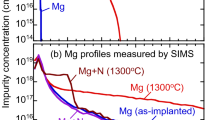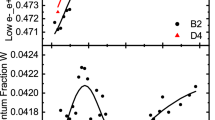Abstract
Two samples of high purity InP extracted from the same wafer were examined by positron annihilation spectrum analysis after having been, processed by means of thermal Neutron Transmutation Doping (NTD). Compared with the as grown sample with an average positron lifetime of 246 ps at 300 K, the high dose doped one has an average lifetime of 251 ps and the lower dose doped one 248 ps measured under the same condition, indicating that some defects have been introduced in the NTD process. Annealing experimental results show a steady decrease in the average lifetime with increasing annealing temperature up to 550°C. And a peak in lifetime curve around 500°C was observed which may be attributed to defects related structure conversion. Temperature experiments conducted on the low dose doped sample from 150K to 290 K suggest the existence of vacancy-impurity complex which have given rise to an abnormal reduction of average lifetime with increasing temperature. Also a n-type InP sample (A61) was irradiated with thermal neutrons in another reactor and the lifetime results display an increase of 15 ps. Furthermore, to study epithermal neutron irradiation effects on InP, measurements were performed on an n-type InP sample (N119) along with one p-type sample (P118) after having been irradiated with high fluence of epithermal neutrons. The former has an average lifetime of 262 ps and the latter 247 ps after irradiation. The results prove that on some occassion epithermal neutrons can produce sizable defects in InP.
Similar content being viewed by others
References
Vesaghi M A. Electrical properties of NTD GaAs[J].Phys Rev. B, 1982,25:5436.
Lee B, Pan N, Stillman G E. Neutron transmutation doping of high-purity Inp[J].J Appl Phys., 1987,62: 1129.
Najda S P, Holmes S, Stradling R Aet al. Donor identification in neutron-transmutation-doped [J].Semicond Sci Technol., 1989,4:791.
Boudart B, Mari B, Prevot B,et al. Efficency of neutron transmuation doping of Inp investigated by opical and electrical methods[J].Nucl. Instruments and Meth in Phys Res B, 1992,63:101.
Bretagon T, Dannefaer S, Kerr T. Indium vacancy in as-grown Inp: A positron annihiation study[J].J. Appl Phys, 1993,73:4697.
Puska M J, Makinen S, Manninen M,et al. Screening of positron, in semiconductors and insulators[J].Phys Rev B, 1989,39:7666.
Navarro F J, Damonte L C, Mari B,et al. Positron lifetime measurement on neutron-irradiated Inp crystals[J].J Appl Phys, 1995,79, 9043.
Tornqvist M, Corbel C, Liszkay L,et al. Positron lifetime at vacuncies in electron-irradiated indium phosphide[J].Materials, Science and Engineering B, 1994,28:126.
Huang Mao-Rong, Wang Yun-Yu, Yang Jur-Hua,et al. Study on Inp doped with sulphur by positron annihilation[J].Material Science Forum, 1995,383:175–178.
Chen Z Q, Hu X W, Wang S J. Vacancies and impurities Inp studied using positron annihilation spectroscopy[J].Chinese Journal of Semiconductors, 1998,19:185(Ch).
Author information
Authors and Affiliations
Additional information
Foundation item: Supported by the Science Foundation of Hubei Province (203980532)
Biography: WEN Xiang-e (1976-), male, Master candidate, Research direction; majar research interest is defects in semiconductor materials using positron annihilation spectroscopy.
Rights and permissions
About this article
Cite this article
Xiang-e, W., Shi-qing, L., Li, M. et al. Defects in NTD InP probed by positron annihilation spectroscopy. Wuhan Univ. J. Nat. Sci. 4, 290–294 (1999). https://doi.org/10.1007/BF02842353
Received:
Issue Date:
DOI: https://doi.org/10.1007/BF02842353




